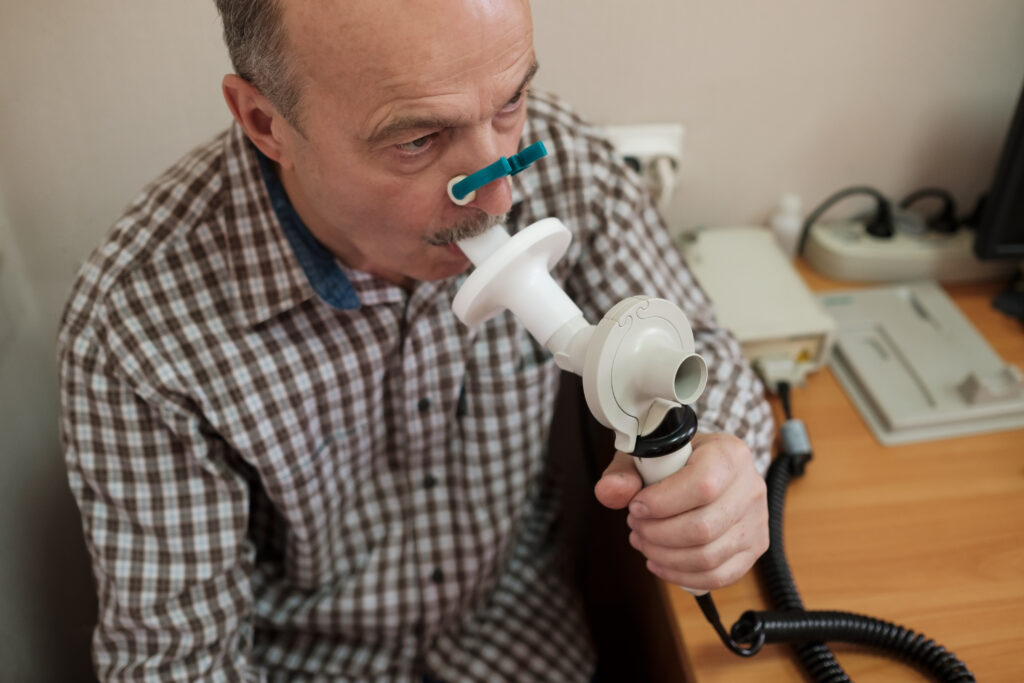Spirometry testing is necessary for an accurate diagnosis of chronic obstructive pulmonary disease (COPD) and is a cornerstone of optimised COPD management. A new report from the Australian Commission on Safety and Quality in Health Care (the Commission) highlights that the people who need it most are missing out.
I did a rapid audit of ten patients I’ve seen in our clinic who have a diagnosis of COPD. I was taken aback by what I found.
Of the ten patients, six had evidence of previous spirometry testing. Four did not. I was surprised. And not surprised.
Of my ten audited patients, three were on long-acting beta2-agonist (LABA)+ inhaled corticosteroids (ICS). The first patient had no spirometry results, and had been started on LABA+ICS “as a trial” for their chronic respiratory symptoms.
The second patient had spirometry results consistently showing FEV1 (forced expiratory volume in one second)/FVC (forced vital capacity) as greater than 0.7 and no significant bronchodilator reversibility — their respiratory symptoms were probably neither COPD nor asthma.
The third patient had their spirometry results interpreted as asthma because there was some bronchodilator reversibility, but the increase in FEV1 was < 12% and < 200 mLand the FEV1/FVC was less than 0.7 — so the more likely diagnosis was COPD.
None of these patients had had frequent or severe exacerbations in the preceding 12 months. There was no clear reason for any of these three patients to have been given an ICS.

Why so many misdiagnoses?
COPD is the fifth highest contributor to overall disease burden in Australia and accounts for half of all respiratory disease burden. Despite its impact, COPD is often underdiagnosed or misdiagnosed. To diagnose COPD, we are reliant on one essential test: spirometry. COPD cannot be diagnosed accurately based on symptoms or a chest x-ray alone.
The newly released Australian Atlas of Healthcare Variation (Atlas) Focus Report: COPD, from the Commission, highlights a concerning trend: the national use of spirometry testing is declining. Between 2015–16 and 2022–23, the rate of spirometry services fell by 31%, despite the prevalence of COPD remaining stable. A 2024 MedicineInsight report showed that only 40% of people with COPD have had a spirometry test, raising real concerns that many are being treated without a confirmed diagnosis.
Released in June 2025, the Atlas Focus Report follows the launch of the COPD Clinical Care Standard in October 2024. Both aim to improve diagnosis and care by putting spirometry at the centre of COPD management. The Atlas Focus Report examines rates of Medicare Benefits Schedule (MBS)-subsidised spirometry testing for people aged 35 years and over, across national, state and territory, Primary Health Network (PHN), and local area levels. Importantly, rates are based on where people live — not where they received the service — highlighting where the true geographical access gaps are.
Barriers to access
To allow meaningful comparisons, rates are adjusted for differences in age and sex across 340 local areas. While the analysis doesn’t adjust for local COPD prevalence, the variation in spirometry testing rates doesn’t match what we know about patterns of prevalence. People in rural and remote areas — who are more likely to have COPD — were less likely to have had spirometry testing. This suggests that access to essential diagnostic care is unequal across geographic regions.
The national decline in spirometry testing rates was largely driven by a 68% drop in spirometry testing performed in local doctors’ rooms, compared to a 7% drop in spirometry testing that is performed in laboratories. This shift may further disadvantage people living in remote areas or experiencing social disadvantage, as laboratory-based tests can be more expensive and harder to access.
Patient-related barriers to accessing spirometry include feeling too unwell to attend appointments, time and cost pressures, and reduced access during the COVID-19 pandemic. Clinician factors also have been found to play a role — such as the costs of providing a spirometry testing service, beliefs that spirometry testing adds little clinical value or that treatment based on symptoms alone is sufficient.
Make spirometry testing a priority
Spirometry testing can mean the difference between getting the right treatment, or not. For example, ICSs are a first-line treatment for the eosinophilic inflammation seen in asthma. But for the typically neutrophilic inflammation seen in COPD, they are generally much less effective, and have potentially serious side effects. A case-control analysis in Quebec found that cessation of ICS was associated with a 36% decrease in hospitalisation or death from pneumonia. In that context, ICS in COPD should be reserved for those with frequent or severe exacerbations with persistent symptoms despite optimised long-acting bronchodilators.
To reverse the decline in spirometry testing rates and improve care, we must make diagnosis of COPD with spirometry testing a priority. To make spirometry testing more accessible, especially in rural and remote areas, we need novel approaches and policy changes that support both spirometry in general practice, and, where needed, alternative options, such as the Respiratory Care WA Respiratory Hubs.
A diagnosis of COPD — and completion of spirometry testing — should be considered in any person over the age of 35 years who has regular symptoms such as dyspnoea, cough, sputum production, a history of recurrent lower respiratory tract infections and/or a history of exposure to risk factors for the disease.
Improving outcomes for people with COPD starts with an accurate diagnosis, and that requires spirometry testing. Making it routine, expected, and accessible is essential to delivering the right care, in the right place, at the right time.
Dr Lee Fong is a Medical Advisor for the Australian Commission on Safety & Quality in Healthcare.
The statements or opinions expressed in this article reflect the views of the authors and do not necessarily represent the official policy of the AMA, the MJA or InSight+ unless so stated.
Subscribe to the free InSight+ weekly newsletter here. It is available to all readers, not just registered medical practitioners.
If you would like to submit an article for consideration, send a Word version to mjainsight-editor@ampco.com.au.

 more_vert
more_vert
Check out Monitored Therapeutics Inc., a lab quality home spirometer system that monitors COPD patients from a central monitoring station. I can’t understand why the home monitoring of COPD patients hasn’t caught on. Avoiding 1 visit to the ER and a hospital stay, pays for the whole thing.
Apparently, it is important to make spirometry testing more accessible, especially in rural and remote areas.
Strange then to quote the Respiratory Care WA Respiratory Hubs, in Joondalup, West Perth, Cockburn & Bunbury – where existing Respiratory testing services already exist. But none in rural/remote WA?
We need to see spirometry as we see HTN and blood pressure medications, we would not think of changing hypertensives without tracking BP so why do we not track lung function/Peak flows etc when changing/stepping up or stepping down inhaler therapy. Spirometry needs to be more accessible, affordable and seen as priority
A thoughtful article but we need to discuss the anemic amount that is the spirometry rebate for gp’s, particularly if the test is negative! A reasonable Medicare rebate would go a long way to reversing the decline.
Great article. While it is encouraging to see the insightful call for accurate evidence to guide pharmacological management, I found it disappointing that the potential contribution by respiratory physiotherapists was not mentioned in this article. The physiotherapy curriculum prepares physiotherapy graduates to conduct accurate spirometry testing. Most importantly, graduates have the ability to interpret the recorded data and apply these findings as appropriate outcome measures of physiotherapeutic interventions (e.g. evaluation of the effectiveness of a pulmonary rehabilitation program). This article also calls for enhancement of collaborative practice between GPs and respiratory physiotherapists for optimisation of assessment and care of patients at large, with chronic respiratory illness.
Great article Dr Fong. Just need to develop and support those novel approaches and policy changes!